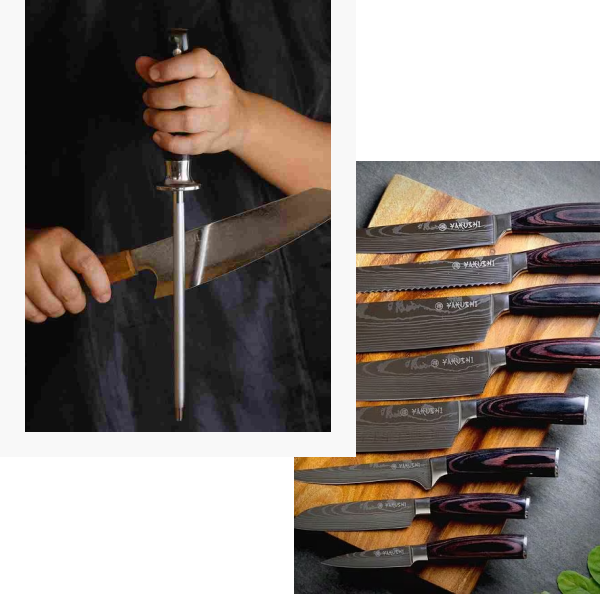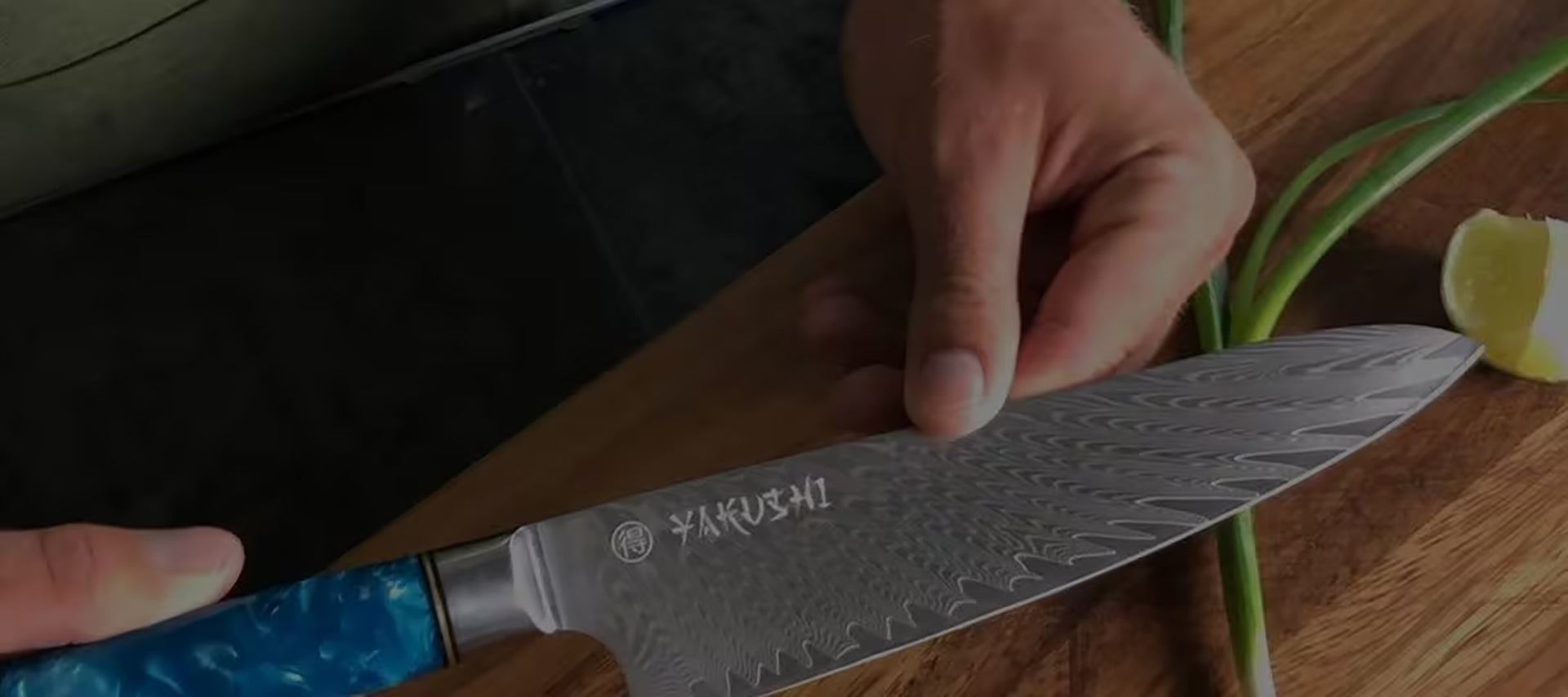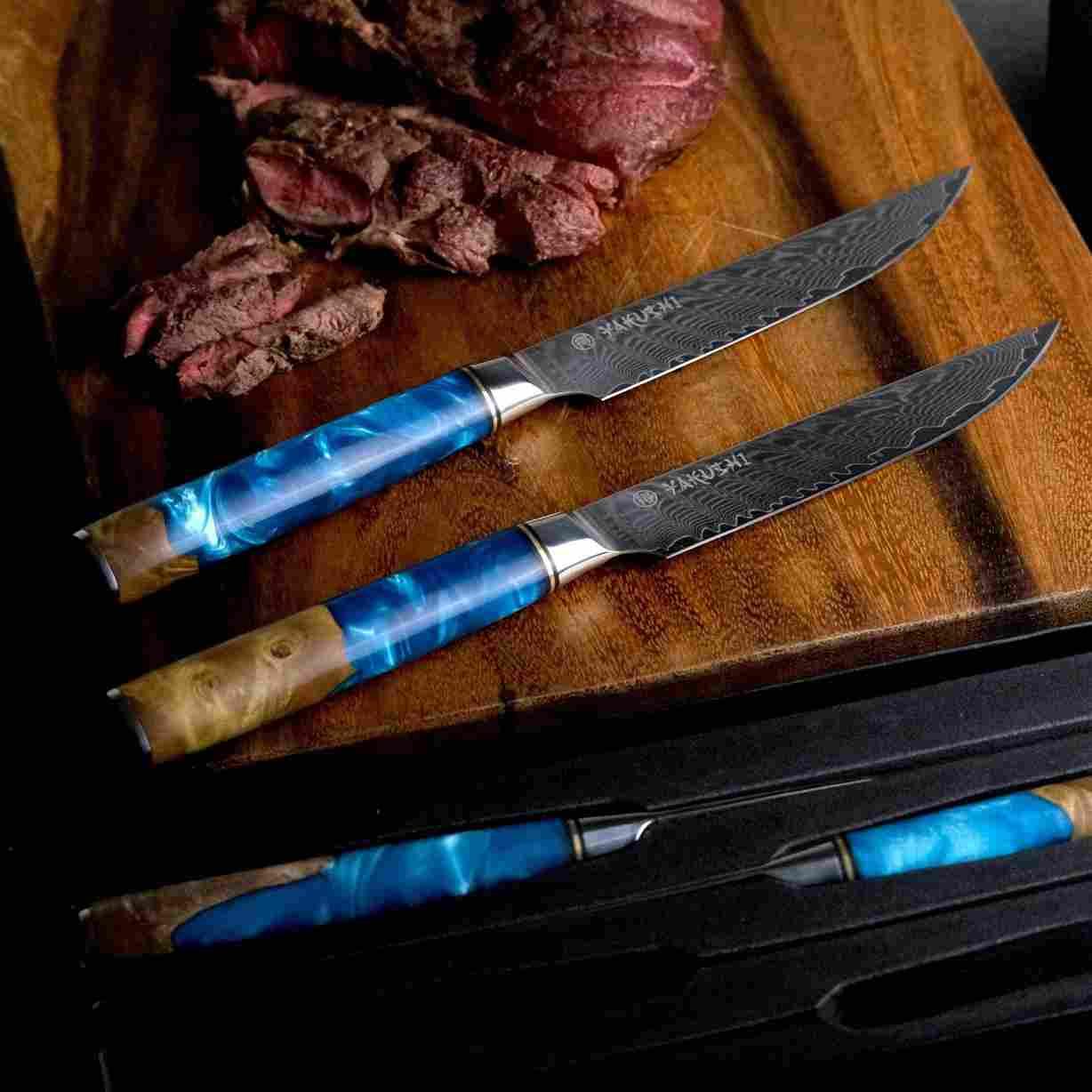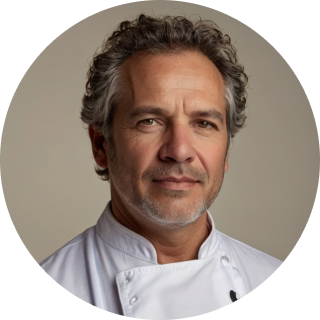Filters
6 products
High quality kitchen knives are a must-have for making your kitchen chores easier. Get ready to dive into the incredible world of the best kitchen knives at Yakushi Knives!
Even if you already have a few knives in your kitchen, you must check out and shop for the best kitchen knife set available at our online store. From filleting to rough chopping and from dicing and slicing to everything that you need to cut through in your kitchens, we have the most unique set of kitchen knives for your various cutting needs.
Reflecting the acumen of fine making and stunning ergonomic handle designs, each kitchen knife at our store is made of premium Damascus steel and a wooden handle. Incorporating a protective bolster and featuring a 15-degree blade angle, our passionately designed chef knife set ensures peak performance and a superb experience for all cooking enthusiasts.
Whether you are looking for a sturdy & comfortable grip or wish to have a great balance of sharp edge retention in your knife, the various chef knives sets at Yakushi Knives will let you experience everything that you expect from premium quality kitchen knives.
Glance through our diverse range of kitchen knives sets today and take your pick!
The perfection in chopping, slicing, dicing, and mincing needs support from a robust & sharp blade along with a comfortable grip. Yakushi combines these characteristics to craft knives that privilege the chefs with accelerated chopping and perfectly minced ingredients for every recipe.
Scroll below to have a glimpse of our diverse knives possessing unique properties.
Yakushi™ Damascus Steel Chef Knife
A seamless blend of beauty and functionality- this Damascus steel blade is handcrafted with a mesmerizing pattern, sharp edge, and comfortable handle. The 67 layers of Japanese Damascus VG-10 steel is the factor for the knife’s durability. Ergonomic wood and blue resin handle is a balanced chopping experience.
Yakushi™ Damascus Kiritsuke Knife
The Kiritsuke blade is the forte of this knife, making it versatile to function from consistent vegetable slicing to smooth gliding into the meat. Octagonally-composed sandalwood handle gives versatility while working with different cutting techniques. The unique pattern, blending of different hues on the handle along with captivating design on the blade combine to make it visually appealing.
Yakushi™ Handmade Butcher Knife
A true companion for heavy choppings- the knife satisfyingly slices through the toughness of the meat. Its 7’’ blade is framed using high-carbon premium Serbian steel and the handle is manufactured using polished Pakka wood.
The grace of this knife is an add-on to both- elevation in chopping experience as well as your kitchen’s style statement. Having an 8” blade, the knife is versatile to employ on various cutting tasks.
Check below the quick tips to pick the most suitable knife for you.
Have a look through the different materials from which we compose our array of knives.
Japanese Damascus Steel
A popular choice for knife blades, this material is known for its exceptional patterns and durability. Different kinds of steel are layered concurrently to assemble robustness.
High Carbon Stainless Steel
It combines the properties of high carbon and stainless steel. Its corrosion resistance, high carbon content, and toughness make it a suitable choice for crafting high-end knives.
High Carbon Premium Serbian Steel
The high-carbon steel is a mix of elements like iron ore, coal, and limestone that attain a high level of robustness. Up-scaled content of high carbon gives this alloy high retention and sharpness, making it ideal for Serbian chef knife manufacturing.
To reserve the sharpness and durability of the knives, employ the below-given tips:
Must clean the knives after every use in warm soapy water. Do not keep them in the water for extended periods, which can consequently degrade the handle and blade.
Minimize contact of the knives with other products to keep them away from damage. Use a knife block or magnetic strip to organize them until the next usage session.
Our product Yakushi™ Premium Knife Holder feature safe storage options.
Frequently oiling the blade and the handle keeps them away from rust and other deterioration issues.
Each of our knives has its intended usage and must be operated considering that. For instance, using our classic chef knife to cut hard meat can degrade its sharpness as it is designed for chopping veggies, filleting fish, and other similar substances. Nevertheless, our Handmade Butcher Knife is dedicated to hard-cutting tasks.
Ensuring timely sharpening is a vital aspect of consistently performing knives. Achieve effectiveness in this procedure by utilizing our Yakushi™ Whetstone 3000 & 8000 Grit, while following the below-given techniques.
Sharpening guide: Sharpening at an angle of 15 to 20-degree is preferable for Japanese knives. Make sure to maintain the correct angle, as minor negligence can lead to making it bland instead of honing.
Make sure it's effective by cutting a slice which must be smoothly minced.
Counting on good pro kitchen knives, there are endless possibilities available in the market. The common ones are:
Chefs knife: the multipurpose knife used for chopping, slicing, dicing, and many other functions.
Paring knife: the miniature one utilized for peeling or slicing small fruits and vegs.
Bread knife: A knife that does not crush the bread when gliding through them.
Utility knife: Another versatile addition that fulfills various purposes including meat slicing, sandwich cutting, veg chopping, and others.
Slicing knife: With a long and narrow design, the knife is used for slicing cooked meat.
Cleaver knife: This rectangularly-shaped knife is used for heavy chopping including cutting bones, poultry, and others.
Boning knife: A knife useful for picking out the bones from the meat.
Fillet knife: This long knife is used for filleting and skinning the fish.
Tomato knife: Utilized for chopping and slicing soft fruits and vegs.
Here is how a Japanese knife differs from a Western knife:
Japanese knife blades are thinner, lighter, and sharper than Western ones.
Wooden material is composed of Japanese knife handles whereas Western handles are made using materials like plastic or composite materials.
Japanese knives are made of harder steel than Western ones.
One material cannot be determined as superior to others as every element of metal has its own significance and purpose. For instance, high-carbon steel is known for its durability and sharpness whereas Damascus steel has the forte of visual appeal as well as excellent edge retention.
The frequency of sharpening is directly proportional to the use of the knives. However, a regularly used knife should be sharpened every 2-3 months.
You can care for your knives by cleaning them after every use, storing in suitable covers or holders, oiling them regularly, and sharpening them once in a while.
It is not recommended to wash the knives in a dishwasher due to the reasons listed below:
Risk of damage to the knife’s blade.
The dishwasher may undergo structural damage or scratches from the sharp edges.
If washed with other dishes, there is a probability of damage to the utensils.
You can store your knives safely in one of our knife holders and bags. Explore and buy our safe knife storage products such as Yakushi’s Mounted knife holders, knife roll bags, and premium knife holders.
Achieving accuracy in every cut comes with the use of the right blade. Our knife sets are made of different materials that let you feature diversity in your work. Have a look at our available knife sets:

About the Knives
We are passionate craftsmen, dedicated to creating exceptional Japanese knives that embody beauty, function, and tradition. We use only the finest materials and employ conventional forging techniques to ensure that our knives are not only razor-sharp and durable but also a work of art.

WATCH VIDEO

Yakushi™ Damascus Steel Chef Knife
A Classy Handcrafted Set, Not only for special occasions.
This Steak Knife Set includes four beautifully crafted knives, making it perfect for families or small dinner parties. The knives come in a stylish box, making it an excellent gift for any steak lover in your life.
I really like the traditional look. They have perfect balance and grip. Incredibly sharp as well!

The Knives are perfect and sharp! I love chopping vegetables with my family now!

I ordered the 5 Piece Set and it exceeds my expectations!
